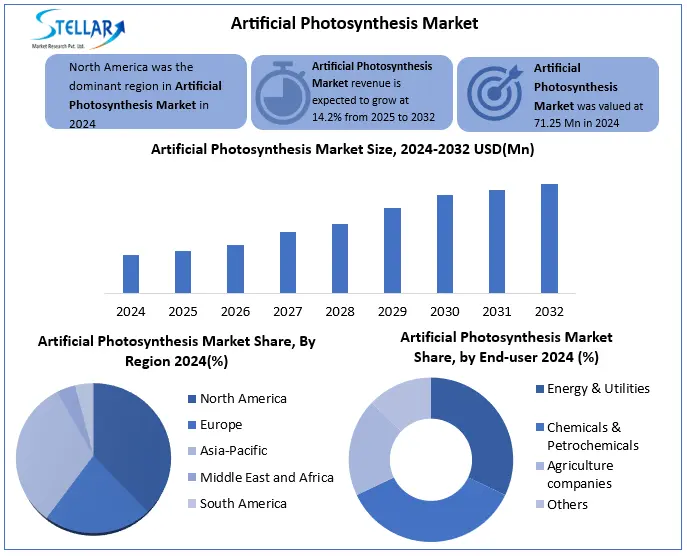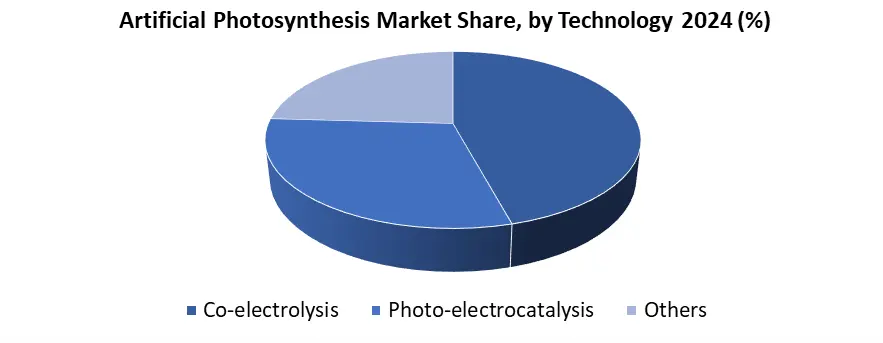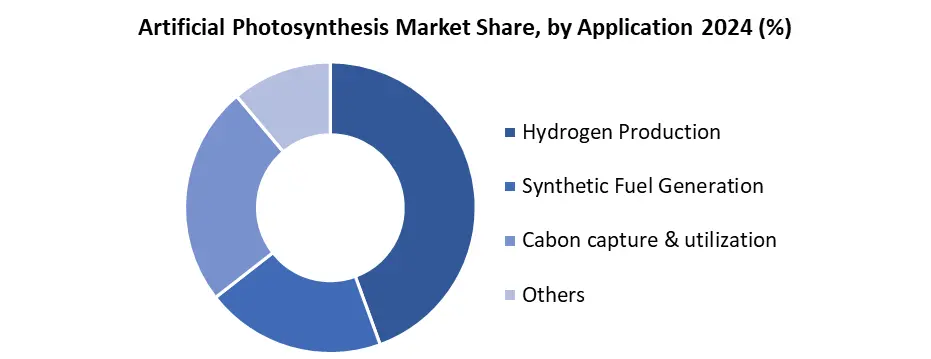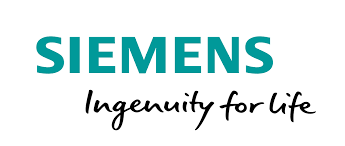Artificial Photosynthesis Market 2025–2032: Size, Share, Growth Trends, by Technology & Application, Key Players Overview
The Artificial Photosynthesis Market was estimated at USD 71.25 Mn. in 2024 and is expected to grow at a CAGR of 14.2% from 2025 to 2032, reaching nearly USD 206.12 Mn. by 2032.
Format : PDF | Report ID : SMR_2796
Artificial Photosynthesis Market Overview:
Artificial Photosynthesis is a process that mimics natural photosynthesis to convert solar energy into chemical fuels, like hydrogen or other high-energy compounds.
Artificial photosynthesis market is gaining momentum as a clean energy solution, which is fueled by the increasing global demand for permanent fuel options, especially green hydrogen. Major development drivers include carbon emissions, government-supported R&D initiatives and increasing concerns over rising investments in renewable energy technologies. The availability of main materials such as semiconductor catalysts and frequent solar infrastructure requirement affects the dynamics of supply, but demand is increasing rapidly due to decarbonization goals in areas such as transport, chemicals and power generation. By region, North America dominates artificial photosynthesis market, due to advanced research institutions and corporate involvement. Major players in this market are SunHydrogen, Twelve, Siemens Energy, Panasonic, ENGIE. Due to technological innovation, artificial photosynthesis is ready to play an important role in future energy mix and market growth during forecasted period.

To get more Insights: Request Free Sample Report
Artificial Photosynthesis Market Dynamics
Surge in Green Hydrogen Demand to Boost the Artificial Photosynthesis Market
The strongest force powering the artificial photosynthesis market is the rising global demand for green hydrogen. As the countries aim for carbon neutrality, hydrogen produced through permanent methods is seen as a major enabler for decarbonizing industries such as steel, aviation and chemicals. In 2024, artificial photosynthesis applications in hydrogen production accounts for more than 60% of market share. Governments are majorly funding for artificial photosynthesis technology, with more than 35 countries developing hydrogen roadmaps, this demand is expected to maintain long term investment in artificial photosynthesis technologies.
Market Faces Restraints Related to Limited Scalability and Commercial Readiness
One of the major roadblocks in artificial photosynthesis market is difficulty in scaling from lab to real-world applications. Currently, over 80% of artificial photosynthesis projects are still in pilots or performance stages, reaching very few to commercial placement. Factors such as inconsistent photocatalyst performance, decline in systems over time, and integration complications with existing energy infrastructure obstruct progress. For example, even promising photoelectrochemical cells that achieve 15-20% efficiency in the lab often drop in field conditions.
Diversified End-Uses to Create Opportunites for Artificial Photosynthesis Market
The future of artificial photosynthesis market looks bright. Beyond hydrogen, the technology is produce synthetic hydrocarbons, fertilizers and special chemicals. Innovations in co-electrolysis and photo-electrocatalysis are improving efficiency, with some lab systems reaching solar to chemical efficiencies above 15-20%. the dual benefit of carbon capture using CO2 as a raw material positions artificial photosynthesis as a powerful climate solution. It not only reduce emissions but it actively recycles CO2, making it important to the development of a circular carbon economy. This dual functionality of fuel manufacturing and carbon usage makes artificial photosynthesis an opportunity for a high impact in global markets.
Artificial Photosynthesis Market Segment Analysis
Based on Technology, the artificial photosynthesis market is segmented into co-electrolysis, photo-electrocatalysis and others. In that co-electrolysis segment dominated the market in 2024 and is expected to hold the largest market share over the forecast period (2025-2032). By 2025, it is estimated to more than 50% of the total technology market, mainly due to its compatibility with existing electrolysis infrastructure and relatively high maturity. Co-electrolysis works simultaneously by reducing carbon dioxide and water in Syngas it is a mixture of hydrogen and carbon monoxide and processed into synthetic fuels like menthol or Fischer-Tropsch diesel. This dualwork capacity not only improves energy efficiency, but also increases carbon use, which is ideal for both fuel production and emission reduction.

Based on Application, the artificial photosynthesis market is segmented into Hydrogen production, Synthetic fuel generation, Carbon capture and utilization and others. The Hydrogen production segment dominated the market in 2024 and is expected to hold the largest market share over the forecast period (2025-2032). This dominance is fueled by immediate global requirement of clean, carbon-free hydrogen, which are seen as a foundation for decarbonizing sectors to areas such as steel, cement, refining and long-haul transportation.
The hydrogen production application has potential to generate hydrogen on-site, off-grid, and with minimal environmental footprint. According to the International Energy Agency, the global demand for clean hydrogen is reach more than 500 million tonnes annually by 2050, making artificial photosynthesis an important enabler of that transition, particularly in sun-rich regions with limited access to power infrastructure.

Artificial Photosynthesis Market Regional Analysis
The North America region dominated the Market in 2024 and is expected to hold the largest Market share over the forecast period (2024-2032)
This leadership is fuel by a strong ecosystem of world class research institutes, government funding and early phase commercial activity. The United States play an important role through initiatives like the "fuel from sunlight" program of the Department of Energy, which invests over USD 100 million in artificial photosynthesis R&D. Institutions such as Caltech, National Renewable Energy Laboratory are driving innovation in photo-electrocatalysis and co-electrolysis technologies, collaborating with clean-tech startups and federal labs. The presence of leading startups such as Sunhydrogen and twelve, which is a collaboration with Inflation Reduction Act, has created productive land for pilot-scale projects and commercialization. These factors made North America a dominant region in artificial photosynthesis market.
Artificial Photosynthesis Market Competitive Landscape
Artificial photosynthesis market is currently dominated by research-operating startups and public-private cooperations with increasing number of industrial players entering the area through strategic investment and participation. Key players such as Sunhydrogen, which is developing a nanoparticle-based solar hydrogen panel aimed at decentralized, low-cost green hydrogen production. Another key innovator is Twelve, a carbon transformation company using artificial photosynthesis principles to convert CO2 into jet fuel, chemicals, and plastics.
Recent development in Artificial Photosynthesis Market
|
Date
|
Company |
Development |
|
February 18, 2025 |
Twelve (USA) |
Twelve secured an additional USD 83 million in Series?C and project funding. New investors include Amazon’s Climate Pledge Fund, Mitsui, and the Development Bank of Japan, accelerating AirPlant One and expanding global carbon-to-fuel deployments. |
|
September 19, 2024 |
Twelve (USA) |
Twelve unveiled a massive $645 million fund raise led by TPG Rise Climate to scale its technology converting CO2 into sustainable aviation fuel (E?Jet). |
|
February 10, 2024 |
UNIST (South Korea) |
Ulsan National Institute of Science & Technology researchers published a Nature?Energy study showcasing a scalable PEC (photoelectrochemical) system for green hydrogen production under real sunlight. This marks significant progress in efficiency, stability, and modular design. |
|
Artificial Photosynthesis Market Scope |
|
|
Market Size in 2024 |
USD 71.25 Mn. |
|
Market Size in 2032 |
USD 206.12 Mn. |
|
CAGR (2024-2032) |
14.2% |
|
Historic Data |
2019-2024 |
|
Base Year |
2024 |
|
Forecast Period |
2025-2032 |
|
Segments |
By Technology Co-electrolysis Photo-electrocatalysis Others |
|
By Application Hydrogen Production Synthetic Fuel Generation Carbon capture and utilization Others |
|
|
By End-user Energy & Utilities Chemicals & Petrochemicals Agriculture companies Others |
|
|
Regional Scope |
North America- United States, Canada, and Mexico Europe – UK, France, Germany, Italy, Spain, Sweden, Russia, and Rest of Europe Asia Pacific – China, South Korea, Japan, India, Australia, Indonesia, Philippines, Malaysia, Vietnam, Thailand, Rest of APAC Middle East and Africa - South Africa, GCC, Egypt, Nigeria, Rest of the Middle East and Africa South America – Brazil, Argentina, Rest of South America |
Key Players in the Artificial Photosynthesis Market
North America
- SunHydrogen (USA)
- Twelve (USA)
- Heliogen (USA)
- Opus 12 (USA)
- Berkeley Lab – Liquid Sunlight Alliance (USA)
- Hypersolar Inc. (USA)
- Caltech – Joint Center for Artificial Photosynthesis (USA)
Europe
- Sunfire GmbH (Germany)
- Siemens Energy (Germany)
- SOLAR2CHEM Consortium (EU – Coordinated in Spain)
- Engie (France)
Asia Pacific
- Panasonic Corporation (Japan)
- NTT Corporation (Japan)
- NEDO – New Energy and Industrial Technology Development Organization (Japan)
- Ulsan National Institute of Science & Technology – UNIST (South Korea)
Frequently Asked Questions
The Surge in Green Hydrogen Demand to Boost the Artificial Photosynthesis Market.
SunHydrogen, Twelve and Siemens Energy are the key competitors in the Artificial Photosynthesis Market.
Diversified End-Uses and Carbon Capture is an Opportunity for Artificial Photosynthesis Market.
The Hydrogen production segment dominated the Artificial Photosynthesis Market.
1. Artificial Photosynthesis Market Introduction
1.1. Study Assumption and Market Definition
1.2. Scope of the Study
1.3. Executive Summary
2. Global Artificial Photosynthesis Market: Competitive Landscape
2.1. SMR Competition Matrix
2.2. Competitive Landscape
2.3. Key Players Benchmarking
2.3.1. Company Name
2.3.2. Product Segment
2.3.3. Distribution Channel Segment
2.3.4. Revenue (2024)
2.4. Leading Artificial Photosynthesis Market Companies, by Market Capitalization
2.5. Market Structure
2.5.1. Market Leaders
2.5.2. Market Followers
2.5.3. Emerging Players
2.6. Mergers and Acquisitions Details
3. Artificial Photosynthesis Market: Dynamics
3.1. Artificial Photosynthesis Market Trends by Region
3.1.1. North America Artificial Photosynthesis Market Trends
3.1.2. Europe Artificial Photosynthesis Market Trends
3.1.3. Asia Pacific Artificial Photosynthesis Market Trends
3.1.4. Middle East & Africa Artificial Photosynthesis Market Trends
3.1.5. South America Artificial Photosynthesis Market Trends
3.2. Artificial Photosynthesis Market Dynamics by Global
3.3. PORTER’s Five Forces Analysis
3.4. PESTLE Analysis
3.5. Value Chain Analysis
3.6. Regulatory Landscape by Region
3.6.1. North America
3.6.2. Europe
3.6.3. Asia Pacific
3.6.4. Middle East & Africa
3.6.5. South America
4. Artificial Photosynthesis Market: Global Market Size and Forecast by Segmentation (by Value USD Mn) (2024-2032)
4.1. Artificial Photosynthesis Market Size and Forecast, By Technology (2024-2032)
4.1.1. Co-electrolysis
4.1.2. Photo-electrocatalysis
4.1.3. Others
4.2. Artificial Photosynthesis Market Size and Forecast, By Application (2024-2032)
4.2.1. Hydrogen Production
4.2.2. Synthetic Fuel Generation
4.2.3. Carbon capture and utilization
4.2.4. Others
4.3. Artificial Photosynthesis Market Size and Forecast, By End-user (2024-2032)
4.3.1. Energy & Utilities
4.3.2. Chemicals & Petrochemicals
4.3.3. Agriculture companies
4.3.4. Others
4.4. Artificial Photosynthesis Market Size and Forecast, By Region (2024-2032)
4.4.1. North America
4.4.2. Europe
4.4.3. Asia Pacific
4.4.4. Middle East & Africa
4.4.5. South America
5. North America Artificial Photosynthesis Market Size and Forecast by Segmentation (by Value USD Mn) (2024-2032)
5.1. North America Artificial Photosynthesis Market Size and Forecast, By Technology (2024-2032)
5.1.1. Co-electrolysis
5.1.2. Photo-electrocatalysis
5.1.3. Others
5.2. North America Artificial Photosynthesis Market Size and Forecast, By Application (2024-2032)
5.2.1. Hydrogen Production
5.2.2. Synthetic Fuel Generation
5.2.3. Carbon capture and utilization
5.2.4. Others
5.3. North America Artificial Photosynthesis Market Size and Forecast, By End-user (2024-2032)
5.3.1. Energy & Utilities
5.3.2. Chemicals & Petrochemicals
5.3.3. Agriculture companies
5.3.4. Others
5.4. North America Artificial Photosynthesis Market Size and Forecast, by Country (2024-2032)
5.4.1. United States
5.4.1.1. United States Artificial Photosynthesis Market Size and Forecast, By Technology (2024-2032)
5.4.1.1.1. Co-electrolysis
5.4.1.1.2. Photo-electrocatalysis
5.4.1.1.3. Others
5.4.1.2. United States Artificial Photosynthesis Market Size and Forecast, By Application (2024-2032)
5.4.1.2.1. Energy & Utilities
5.4.1.2.2. Chemicals & Petrochemicals
5.4.1.2.3. Agriculture companies
5.4.1.2.4. Others
5.4.1.3. United States Artificial Photosynthesis Market Size and Forecast, By End-user (2024-2032)
5.4.1.3.1. Energy & Utilities
5.4.1.3.2. Chemicals & Petrochemicals
5.4.1.3.3. Agriculture companies
5.4.1.3.4. Others
5.4.2. Canada
5.4.2.1. Canada Artificial Photosynthesis Market Size and Forecast, By Technology (2024-2032)
5.4.2.1.1. Co-electrolysis
5.4.2.1.2. Photo-electrocatalysis
5.4.2.1.3. Others
5.4.2.2. Canada Artificial Photosynthesis Market Size and Forecast, By Application (2024-2032)
5.4.2.2.1. Hydrogen Production
5.4.2.2.2. Synthetic Fuel Generation
5.4.2.2.3. Carbon capture and utilization
5.4.2.2.4. Others
5.4.2.3. Canada Artificial Photosynthesis Market Size and Forecast, By End-user (2024-2032)
5.4.2.3.1. Energy & Utilities
5.4.2.3.2. Chemicals & Petrochemicals
5.4.2.3.3. Agriculture companies
5.4.2.3.4. Others
5.4.3. Mexico
5.4.3.1. Mexico Artificial Photosynthesis Market Size and Forecast, By Technology (2024-2032)
5.4.3.1.1. Co-electrolysis
5.4.3.1.2. Photo-electrocatalysis
5.4.3.1.3. Others
5.4.3.2. Mexico Artificial Photosynthesis Market Size and Forecast, By Application (2024-2032)
5.4.3.2.1. Hydrogen Production
5.4.3.2.2. Synthetic Fuel Generation
5.4.3.2.3. Carbon capture and utilization
5.4.3.2.4. Others
5.4.3.3. Mexico Artificial Photosynthesis Market Size and Forecast, By End-user (2024-2032)
5.4.3.3.1. Energy & Utilities
5.4.3.3.2. Chemicals & Petrochemicals
5.4.3.3.3. Agriculture companies
5.4.3.3.4. Others
6. Europe Artificial Photosynthesis Market Size and Forecast by Segmentation (by Value USD Mn) (2024-2032)
6.1. Europe Artificial Photosynthesis Market Size and Forecast, By Technology (2024-2032)
6.2. Europe Artificial Photosynthesis Market Size and Forecast, By Application (2024-2032)
6.3. Europe Artificial Photosynthesis Market Size and Forecast, By End-user (2024-2032)
6.4. Europe Artificial Photosynthesis Market Size and Forecast, by Country (2024-2032)
6.4.1. United Kingdom
6.4.1.1. United Kingdom Artificial Photosynthesis Market Size and Forecast, By Technology (2024-2032)
6.4.1.2. United Kingdom Artificial Photosynthesis Market Size and Forecast, By Application (2024-2032)
6.4.1.3. United Kingdom Artificial Photosynthesis Market Size and Forecast, By End-user (2024-2032)
6.4.2. France
6.4.2.1. France Artificial Photosynthesis Market Size and Forecast, By Technology (2024-2032)
6.4.2.2. France Artificial Photosynthesis Market Size and Forecast, By Application (2024-2032)
6.4.2.3. France Artificial Photosynthesis Market Size and Forecast, By End-user (2024-2032)
6.4.3. Germany
6.4.3.1. Germany Artificial Photosynthesis Market Size and Forecast, By Technology (2024-2032)
6.4.3.2. Germany Artificial Photosynthesis Market Size and Forecast, By Application (2024-2032)
6.4.3.3. Germany Artificial Photosynthesis Market Size and Forecast, By End-user (2024-2032)
6.4.4. Italy
6.4.4.1. Italy Artificial Photosynthesis Market Size and Forecast, By Technology (2024-2032)
6.4.4.2. Italy Artificial Photosynthesis Market Size and Forecast, By Application (2024-2032)
6.4.4.3. Italy Artificial Photosynthesis Market Size and Forecast, By End-user (2024-2032)
6.4.5. Spain
6.4.5.1. Spain Artificial Photosynthesis Market Size and Forecast, By Technology (2024-2032)
6.4.5.2. Spain Artificial Photosynthesis Market Size and Forecast, By Application (2024-2032)
6.4.5.3. Spain Artificial Photosynthesis Market Size and Forecast, By End-user (2024-2032)
6.4.6. Sweden
6.4.6.1. Sweden Artificial Photosynthesis Market Size and Forecast, By Technology (2024-2032)
6.4.6.2. Sweden Artificial Photosynthesis Market Size and Forecast, By Application (2024-2032)
6.4.6.3. Sweden Artificial Photosynthesis Market Size and Forecast, By End-user (2024-2032)
6.4.7. Austria
6.4.7.1. Austria Artificial Photosynthesis Market Size and Forecast, By Technology (2024-2032)
6.4.7.2. Austria Artificial Photosynthesis Market Size and Forecast, By Application (2024-2032)
6.4.7.3. Austria Artificial Photosynthesis Market Size and Forecast, By End-user (2024-2032)
6.4.8. Rest of Europe
6.4.8.1. Rest of Europe Artificial Photosynthesis Market Size and Forecast, By Technology (2024-2032)
6.4.8.2. Rest of Europe Artificial Photosynthesis Market Size and Forecast, By Application (2024-2032)
6.4.8.3. Rest of Europe Artificial Photosynthesis Market Size and Forecast, By End-user (2024-2032)
7. Asia Pacific Artificial Photosynthesis Market Size and Forecast by Segmentation (by Value USD Mn) (2024-2032)
7.1. Asia Pacific Artificial Photosynthesis Market Size and Forecast, By Technology (2024-2032)
7.2. Asia Pacific Artificial Photosynthesis Market Size and Forecast, By Application (2024-2032)
7.3. Asia Pacific Artificial Photosynthesis Market Size and Forecast, By End-user (2024-2032)
7.4. Asia Pacific Artificial Photosynthesis Market Size and Forecast, by Country (2024-2032)
7.4.1. China
7.4.1.1. China Artificial Photosynthesis Market Size and Forecast, By Technology (2024-2032)
7.4.1.2. China Artificial Photosynthesis Market Size and Forecast, By Application (2024-2032)
7.4.1.3. China Artificial Photosynthesis Market Size and Forecast, By End-user (2024-2032)
7.4.2. S Korea
7.4.2.1. S Korea Artificial Photosynthesis Market Size and Forecast, By Technology (2024-2032)
7.4.2.2. S Korea Artificial Photosynthesis Market Size and Forecast, By Application (2024-2032)
7.4.2.3. S Korea Artificial Photosynthesis Market Size and Forecast, By End-user (2024-2032)
7.4.3. Japan
7.4.3.1. Japan Artificial Photosynthesis Market Size and Forecast, By Technology (2024-2032)
7.4.3.2. Japan Artificial Photosynthesis Market Size and Forecast, By Application (2024-2032)
7.4.3.3. Japan Artificial Photosynthesis Market Size and Forecast, By End-user (2024-2032)
7.4.4. India
7.4.4.1. India Artificial Photosynthesis Market Size and Forecast, By Technology (2024-2032)
7.4.4.2. India Artificial Photosynthesis Market Size and Forecast, By Application (2024-2032)
7.4.4.3. India Artificial Photosynthesis Market Size and Forecast, By End-user (2024-2032)
7.4.5. Australia
7.4.5.1. Australia Artificial Photosynthesis Market Size and Forecast, By Technology (2024-2032)
7.4.5.2. Australia Artificial Photosynthesis Market Size and Forecast, By Application (2024-2032)
7.4.5.3. Australia Artificial Photosynthesis Market Size and Forecast, By End-user (2024-2032)
7.4.6. Indonesia
7.4.6.1. Indonesia Artificial Photosynthesis Market Size and Forecast, By Technology (2024-2032)
7.4.6.2. Indonesia Artificial Photosynthesis Market Size and Forecast, By Application (2024-2032)
7.4.6.3. Indonesia Artificial Photosynthesis Market Size and Forecast, By End-user (2024-2032)
7.4.7. Philippines
7.4.7.1. Philippines Artificial Photosynthesis Market Size and Forecast, By Technology (2024-2032)
7.4.7.2. Philippines Artificial Photosynthesis Market Size and Forecast, By Application (2024-2032)
7.4.7.3. Philippines Artificial Photosynthesis Market Size and Forecast, By End-user (2024-2032)
7.4.8. Malaysia
7.4.8.1. Malaysia Artificial Photosynthesis Market Size and Forecast, By Technology (2024-2032)
7.4.8.2. Malaysia Artificial Photosynthesis Market Size and Forecast, By Application (2024-2032)
7.4.8.3. Malaysia Artificial Photosynthesis Market Size and Forecast, By End-user (2024-2032)
7.4.9. Vietnam
7.4.9.1. Vietnam Artificial Photosynthesis Market Size and Forecast, By Technology (2024-2032)
7.4.9.2. Vietnam Artificial Photosynthesis Market Size and Forecast, By Application (2024-2032)
7.4.9.3. Vietnam Artificial Photosynthesis Market Size and Forecast, By End-user (2024-2032)
7.4.10. Thailand
7.4.10.1. Thailand Artificial Photosynthesis Market Size and Forecast, By Technology (2024-2032)
7.4.10.2. Thailand Artificial Photosynthesis Market Size and Forecast, By Application (2024-2032)
7.4.10.3. Thailand Artificial Photosynthesis Market Size and Forecast, By End-user (2024-2032)
7.4.11. ASEAN
7.4.11.1. ASEAN Artificial Photosynthesis Market Size and Forecast, By Technology (2024-2032)
7.4.11.2. ASEAN Artificial Photosynthesis Market Size and Forecast, By Application (2024-2032)
7.4.11.3. ASEAN Artificial Photosynthesis Market Size and Forecast, By End-user (2024-2032)
7.4.12. Rest of Asia Pacific
7.4.12.1. Rest of Asia Pacific Artificial Photosynthesis Market Size and Forecast, By Technology (2024-2032)
7.4.12.2. Rest of Asia Pacific Artificial Photosynthesis Market Size and Forecast, By Application (2024-2032)
7.4.12.3. Rest of Asia Pacific Artificial Photosynthesis Market Size and Forecast, By End-user (2024-2032)
8. Middle East and Africa Artificial Photosynthesis Market Size and Forecast by Segmentation (by Value USD Mn) (2024-2032)
8.1. Middle East and Africa Artificial Photosynthesis Market Size and Forecast, By Technology (2024-2032)
8.2. Middle East and Africa Artificial Photosynthesis Market Size and Forecast, By Application Model (2024-2032)
8.3. Middle East and Africa Artificial Photosynthesis Market Size and Forecast, By End-user (2024-2032)
8.4. Middle East and Africa Artificial Photosynthesis Market Size and Forecast, by Country (2024-2032)
8.4.1. South Africa
8.4.1.1. South Africa Artificial Photosynthesis Market Size and Forecast, By Technology (2024-2032)
8.4.1.2. South Africa Artificial Photosynthesis Market Size and Forecast, By Application Model (2024-2032)
8.4.1.3. South Africa Artificial Photosynthesis Market Size and Forecast, By End-user (2024-2032)
8.4.2. GCC
8.4.2.1. GCC Artificial Photosynthesis Market Size and Forecast, By Technology (2024-2032)
8.4.2.2. GCC Artificial Photosynthesis Market Size and Forecast, By Application Model (2024-2032)
8.4.2.3. GCC Artificial Photosynthesis Market Size and Forecast, By End-user (2024-2032)
8.4.3. Nigeria
8.4.3.1. Nigeria Artificial Photosynthesis Market Size and Forecast, By Technology (2024-2032)
8.4.3.2. Nigeria Artificial Photosynthesis Market Size and Forecast, By Application Model (2024-2032)
8.4.3.3. Nigeria Artificial Photosynthesis Market Size and Forecast, By End-user (2024-2032)
8.4.4. Rest of ME&A
8.4.4.1. Rest of ME&A Artificial Photosynthesis Market Size and Forecast, By Technology (2024-2032)
8.4.4.2. Rest of ME&A Artificial Photosynthesis Market Size and Forecast, By Application Model (2024-2032)
8.4.4.3. Rest of ME&A Artificial Photosynthesis Market Size and Forecast, By End-user (2024-2032)
9. South America Artificial Photosynthesis Market Size and Forecast by Segmentation (by Value USD Mn) (2024-2032)
9.1. South America Artificial Photosynthesis Market Size and Forecast, By Technology (2024-2032)
9.2. South America Artificial Photosynthesis Market Size and Forecast, By Application (2024-2032)
9.3. South America Artificial Photosynthesis Market Size and Forecast, By End-user (2024-2032)
9.4. South America Artificial Photosynthesis Market Size and Forecast, by Country (2024-2032)
9.4.1. Brazil
9.4.1.1. Brazil Artificial Photosynthesis Market Size and Forecast, By Technology (2024-2032)
9.4.1.2. Brazil Artificial Photosynthesis Market Size and Forecast, By Application (2024-2032)
9.4.1.3. Brazil Artificial Photosynthesis Market Size and Forecast, By End-user (2024-2032)
9.4.2. Argentina
9.4.2.1. Argentina Artificial Photosynthesis Market Size and Forecast, By Technology (2024-2032)
9.4.2.2. Argentina Artificial Photosynthesis Market Size and Forecast, By Application (2024-2032)
9.4.2.3. Argentina Artificial Photosynthesis Market Size and Forecast, By End-user (2024-2032)
9.4.3. Rest Of South America
9.4.3.1. Rest Of South America Artificial Photosynthesis Market Size and Forecast, By Technology (2024-2032)
9.4.3.2. Rest Of South America Artificial Photosynthesis Market Size and Forecast, By Application (2024-2032)
9.4.3.3. Rest Of South America Artificial Photosynthesis Market Size and Forecast, By End-user (2024-2032)
10. Company Profile: Key Players
10.1 SunHydrogen
10.1.1. Company Overview
10.1.2. Business Portfolio
10.1.3. Financial Overview
10.1.4. SWOT Analysis
10.1.5. Strategic Analysis
10.1.6. Recent Development
10.2 Twelve
10.3 Heliogen
10.4 Opus 12
10.5 Berkeley Lab – Liquid Sunlight Alliance
10.6 Hypersolar Inc.
10.7 Caltech – Joint Center for Artificial Photosynthesis
10.8 Sunfire GmbH
10.9 Siemens Energy
10.10 SOLAR2CHEM Consortium
10.11 Engie
10.12 Panasonic Corporation
10.13 NTT Corporation
10.14 NEDO – New Energy and Industrial Technology Development Organization
10.15 Ulsan National Institute of Science & Technology – UNIST
11. Key Findings & Analyst Recommendations
12. Artificial Photosynthesis Markets: Research Methodology
















